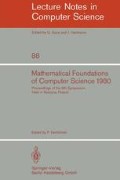Abstract
The paper presents a formal model to specify a data base, a query and the access path which must be followed to obtain the ansewer. The model is based on the problem reduction hypergraphs, for which an admissible and optimal search algorithm is known. An effective method is given to map the data base and the query into a problem reduction hypergraph, which the known search algorithm can be applied to. The optimal solution to the problem reduction hypergraph provides an optimal (and possibly parallel) program to obtain the answer to the given query. Since the model allows to determine the correct answer, if any, without modifications of the data base nor requiring further information, it is an improvement over the models presented in the literature.
This work has been partially supported by G.R.I.S.-C.N.R., under grant n. 7900830.07
Preview
Unable to display preview. Download preview PDF.
References
Carlson, C.R., and Kaplan, R.S. A generalized access path model and its application to a relational data base system. Proc. ACM-SIGMOD Int. Conf. on Management of Data 1976, Washington, D.C., USA, pp. 143–154.
Tsichritzis, D.C., and Lochovski, F.H. Data Base Management Systems. Academic Press, New York (1977).
Levi, G., and Sirovich, F. A problem reduction model for non independent subproblems. Proc. 4th Int. Joint Conf. on Artif. Intel. 1975, Tbilisi, GSSR, USSR, pp. 340–344.
Levi, G., and Sirovich, F. Generalized And/Or graphs. Artificial Intelligence, 7 (1976), pp. 243–259.
Berge, C. Graphes et Hypergraphes. Dunod, Paris (1970).
Chamberlin, D.D., and Boyce, R.F. SEQUEL: A structured English query language, Proc. ACM-SIGMOD Workshop on Data Description, Access and Control 1974, pp. 249–264.
Hanani, M.Z. An optimal evaluation of boolean expressions in an online query system, CACM 20, 5 (1977), pp. 344–347.
Eisner, M.J., and Severance, D.G. Mathematical techniques for efficient record segmentation in large shared data bases, J. ACM 23, 4 (1976), pp. 619–635.
Klar, P. Conditional answer in question-answering systems, 6th Proc. Int. Conf. on Artif. Intel. (1979). Tokyo.
Author information
Authors and Affiliations
Editor information
Rights and permissions
Copyright information
© 1980 Springer-Verlag Berlin Heidelberg
About this paper
Cite this paper
Degano, P., Lomanto, A., Sirovich, F. (1980). On finding the optimal access path to resolve a relational data base query. In: Dembiński, P. (eds) Mathematical Foundations of Computer Science 1980. MFCS 1980. Lecture Notes in Computer Science, vol 88. Springer, Berlin, Heidelberg. https://doi.org/10.1007/BFb0022507
Download citation
DOI: https://doi.org/10.1007/BFb0022507
Published:
Publisher Name: Springer, Berlin, Heidelberg
Print ISBN: 978-3-540-10027-0
Online ISBN: 978-3-540-38194-5
eBook Packages: Springer Book Archive

